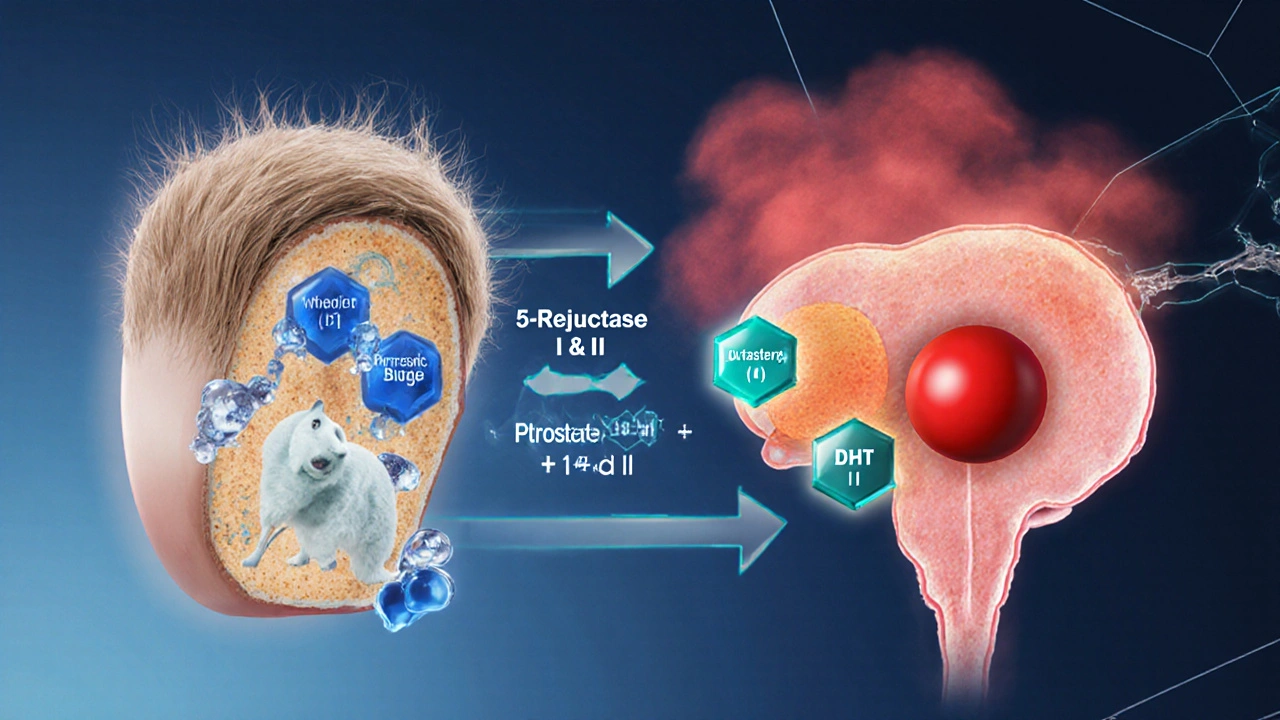Dutasteride vs Alternatives Comparison Tool
| Attribute | Dutasteride (Dutanol) | Finasteride | Minoxidil | Saw Palmetto |
|---|---|---|---|---|
| Mechanism | Inhibits type I & II 5-α-reductase | Inhibits type II 5-α-reductase | Vasodilation, prolongs anagen phase | Weak type I inhibition (herbal) |
| Primary FDA Indication | BPH | BPH (5 mg), Hair Loss (1 mg) | Hair Loss | None (dietary supplement) |
| Typical Dose | 0.5 mg once daily | 5 mg (BPH) or 1 mg (hair loss) | 2% solution, twice daily | 320 mg extract, twice daily |
| DHT Reduction | ≈90% | ≈70% | Not applicable | ≈15-20% (studies vary) |
| Hair Growth Efficacy | 30-40% increase in hair count | 20-30% increase | 15-25% increase | Variable, generally low |
| Side Effects | Lower libido, erectile dysfunction (rare) | Lower libido, erectile dysfunction (rare) | Initial shedding, scalp irritation | Generally well-tolerated |
| Cost (Monthly) | $50-100+ | $10-20 | $20-40 | $15-30 |
Select your condition and symptom severity to get personalized treatment recommendations.
Dutasteride (Dutanol)
Most effective DHT blocker, ideal for severe BPH and hair loss cases. Higher cost but superior efficacy.
High Efficacy Higher CostFinasteride
Cost-effective alternative with proven efficacy for mild-to-moderate conditions. Widely available.
Good Efficacy Low CostMinoxidil
Topical treatment that works via a different mechanism. Great for combining with oral inhibitors.
Good Efficacy Low CostSaw Palmetto
Natural alternative with modest effects. Limited clinical evidence but well-tolerated.
Low Efficacy Low CostWhen doctors talk about chronic prostate enlargement or male‑pattern baldness, one name keeps popping up: Dutasteride. Marketed as Dutanol in some regions, it’s a potent 5‑alpha‑reductase inhibitor that works on both typeI and typeII enzymes. That double‑action makes it stand out from older drugs, but it also raises questions about cost, side‑effects, and whether a different option might suit you better.
Quick Takeaways
- Dutasteride blocks two isoforms of the enzyme that converts testosterone to DHT, offering higher DHT suppression than finasteride.
- It’s approved for benign prostatic hyperplasia (BPH) and, off‑label, for androgenic alopecia.
- Finasteride is cheaper and works well for many men with mild‑to‑moderate hair loss.
- Topical minoxidil treats hair loss via a different pathway and can be combined with oral inhibitors.
- Herbal options like saw palmetto have modest DHT‑lowering effects but lack robust clinical data.
What Is Dutanol (Dutasteride)?
Dutasteride (also marketed as Dutanol) is a prescription medication that belongs to the class of 5‑alpha‑reductase inhibitors. It was first approved by the FDA in 2001 for the treatment of BPH and has since been used off‑label for androgenic alopecia. The drug’s mechanism involves inhibiting both typeI and typeII isoenzymes, reducing dihydrotestosterone (DHT) levels in the prostate and scalp by up to 90%. The reduction in DHT helps shrink enlarged prostate tissue and slows the miniaturization of hair follicles, which is the hallmark of male‑pattern baldness.
Key Alternatives to Consider
Below are the most common alternatives doctors compare against Dutasteride, each with its own mode of action and typical use case.
- Finasteride - a selective typeII inhibitor, approved for BPH (5mg) and androgenic alopecia (1mg).
- Minoxidil - a topical vasodilator that prolongs the anagen phase of hair growth.
- Spironolactone - a potassium‑sparing diuretic with anti‑androgen effects, mainly used in women.
- Saw Palmetto - a herbal extract thought to weakly inhibit typeI 5‑alpha‑reductase.
Comparative Table: Dutasteride vs Major Alternatives
| Attribute | Dutasteride (Dutanol) | Finasteride | Minoxidil (Topical) | Saw Palmetto (Herb) |
|---|---|---|---|---|
| Mechanism | Inhibits typeI & II 5‑α‑reductase | Inhibits typeII 5‑α‑reductase | Vasodilation, prolongs anagen phase | Weak typeI inhibition (herbal) |
| Primary FDA indication | BPH | BPH (5mg), hair loss (1mg) | Hair loss | None (dietary supplement) |
| Typical dose | 0.5mg once daily | 5mg (BPH) or 1mg (hair loss) | 2% solution, twice daily | 320mg extract, twice daily |
| DHT reduction | ≈90% | ≈70% | Not applicable | ≈15‑20% (studies vary) |
| Hair‑growth efficacy (clinical trials) | 30‑40% increase in hair count | 20‑30% increase | 15‑25% increase | Variable, generally <10% |
| Common side effects | Sexual dysfunction, decreased libido, ejaculation disorders | Similar but milder | Scalp irritation, hypertrichosis | Gastrointestinal upset, headache |
| Cost (US$ per month, 2025) | $75‑$120 | $30‑$60 | $25‑$45 | $15‑$30 |

When Dutasteride Is the Right Choice
If you’ve been diagnosed with moderate‑to‑severe BPH and experience urinary symptoms, Dutasteride’s stronger DHT suppression often leads to a faster reduction in prostate volume. For men in their 30s‑40s with early‑stage androgenic alopecia, the off‑label use can deliver noticeable regrowth, especially when combined with topical minoxidil.
Key decision points:
- Severity of DHT‑driven condition: High DHT levels (confirmed by lab) favor Dutasteride.
- Budget considerations: Finasteride or minoxidil are more affordable.
- Tolerance for side effects: If sexual side effects are a deal‑breaker, start with finasteride or a lower‑dose regimen.
- Desire for combination therapy: Many dermatologists pair Dutasteride with minoxidil for synergistic effect.
Potential Risks and How to Mitigate Them
Like any hormone‑modulating drug, Dutasteride carries a profile of adverse events. The most reported are decreased libido, erectile dysfunction, and reduced ejaculate volume. These symptoms usually improve after discontinuation, but persistent cases have been documented.
Best practices to lower risk:
- Schedule a baseline hormone panel before starting therapy.
- Begin with a short trial period (e.g., 3 months) and reassess symptoms.
- Discuss concurrent medications-certain antifungals and HIV protease inhibitors can raise Dutasteride levels.
- Consider intermittent dosing (e.g., 2 weeks on, 1 week off) if side effects become bothersome.
Special Populations and Contra‑indications
Pregnant women must avoid handling crushed or broken pills, as Dutasteride can affect fetal development. Adolescents under 18 are generally excluded from treatment for hair loss because long‑term safety data are lacking.
Patients with severe liver dysfunction should use caution; the drug is metabolized hepatically, and dose adjustment may be required.
How to Talk to Your Doctor About Dutasteride
Approach the conversation with clear goals:
- Explain the condition you want to treat (BPH vs hair loss).
- Bring any recent lab results, especially PSA levels, if relevant.
- Ask about side‑effect monitoring and the timeline for expected improvement.
- Inquire whether a combination regimen (e.g., Dutasteride+minoxidil) is appropriate for you.
Having this checklist ready helps the physician tailor the prescription and set realistic expectations.
Bottom Line: Choosing Between Dutasteride and Its Alternatives
There’s no one‑size‑fits‑all answer. If you need the strongest DHT knock‑down and can manage a higher price tag, Dutasteride often outperforms finasteride and herbal extracts. For mild cases or tighter budgets, finasteride or minoxidil may deliver satisfactory results with fewer side effects. Always weigh efficacy against tolerance, cost, and personal health profile before committing.

Frequently Asked Questions
Can I use Dutasteride for hair loss if I have no prostate issues?
Yes, many dermatologists prescribe it off‑label for androgenic alopecia. Expect a gradual improvement over 6‑12 months, and monitor for sexual side effects.
How does Dutasteride compare to Finasteride in terms of PSA levels?
Both lower PSA because they reduce prostate volume, but Dutasteride usually causes a larger drop (about 50% vs 20% for finasteride). Your doctor should adjust PSA interpretation accordingly.
Is it safe to combine Dutasteride with Minoxidil?
Combining them is common and generally safe because they act on different pathways. The mix can boost hair‑count results by 10‑15% over either drug alone.
What should I do if I experience reduced libido on Dutasteride?
First, speak with your prescriber. Options include lowering the dose, switching to finasteride, or adding a brief drug‑holiday. In most cases, symptoms improve after adjustment.
Are there any natural alternatives that work as well as Dutasteride?
Saw palmetto and pumpkin seed oil show modest DHT reduction, but large‑scale trials have not matched Dutasteride’s efficacy. They may be useful for those seeking a supplement‑only approach.


Jennifer Romand
October 5, 2025 AT 12:13When one peruses the tableau of androgen‑modulating agents, the sheer elegance of dutasteride's dual‑isozyme inhibition becomes almost poetic. Its capacity to suppress near‑90% of DHT eclipses the modest 70% offered by finasteride, a fact that cannot be ignored by the discerning clinician. Yet, the premium price tag does whisper a cautionary tale for the fiscally‑conscious. In practice, the decision often balances efficacy against budgetary constraints.
Chris Fulmer
October 14, 2025 AT 04:39Dutasteride's broader enzyme coverage can really shift the needle for those with stubborn BPH or advanced hair loss. I’ve seen patients report noticeable prostate shrinkage within months. Pairing it with a topical like minoxidil might give that extra boost for hair regrowth.
William Pitt
October 22, 2025 AT 21:04For anyone battling moderate to severe symptoms, jumping straight to dutasteride makes sense. The drug’s potency cuts DHT dramatically, which translates to real symptom relief. Just keep an eye on the rare sexual side effects and talk it through with your doc.
Jeff Hershberger
October 31, 2025 AT 12:29Honestly, the hype around dutasteride feels a bit overblown-sure, it packs a punch, but your wallet might bleed faster than your prostate shrinks. The cost differential is glaring, and the side‑effect profile, while low, isn’t nonexistent. In short, weigh the gains against the pennies.
Jesse Najarro
November 9, 2025 AT 04:54Yeah, dutasteride works well for a lot of folks. Just remember it’s a prescription, so you need a doc’s okay.
Dan Dawson
November 17, 2025 AT 21:20That’s a pricey pill.
Lawrence Jones II
November 26, 2025 AT 13:45Dutasteride’s pharmacodynamics are impressive-90% DHT knockdown is a solid figure. 💊 For BPH, that translates into measurable volume reduction. If you’re comfortable with daily oral meds, it’s a strong contender.
Robert Frith
December 5, 2025 AT 06:10Honestly mate, if you cant afford the fancy pill just take some saw palmetto. It does the job 80% of the time lol. No need to spend the big bucks on dutasteride.
Albert Gesierich
December 13, 2025 AT 22:35There are several factual inaccuracies in the above post. For instance, the statement that finasteride “works well for many men with mild‑to‑moderate hair loss” omits the fact that its efficacy is heavily dose‑dependent. Additionally, the cost ranges cited lack proper citation.
Brad Tollefson
December 22, 2025 AT 15:01The comparison table is clear and well‑structured. However, note that the “≈90%” DHT reduction for dutasteride may vary between studies.